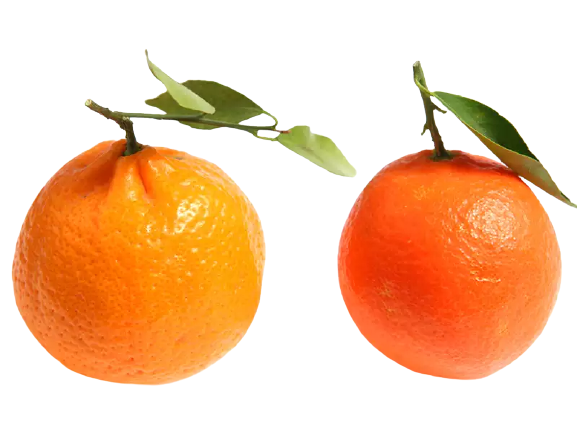Botanical Name – Citrus reticulata
Family – Rutaceae
Origin – China
Ch No – 2n=18
Fruit type- Hesperidium
Inflorescence type – Cymose (Solitary)
Edible part – Juicy Placental Hairs.
Watch Lecture Video
- Mandarin is grown in 50% area under citrus species
- Citrus seeds do not have dormancy, so they should be sown immediately after extraction.
- Flowering three times a year

Mandarin
-
- February flower —— Ambe Bahar
- June Fool —————Mrig Bahar
- October flower ——Hasth Bahar
- Mandarin/Orange are susceptible to waterlogging.
- Rootstock for HDP – Troyer citrange (1.8×1.8m2)
- Best time to prune – late winter or early spring
- Highly polyembryonic – Mandarin, Sweet orange, Lemon, Grapefruit.
- Monoembryonic – Pummelo, Tahiti lime, Citron.
- Rangpur lime is the best rootstock for mandarin and sweet orange.
- Rootstock – Adajamir ( C. assamensis) is resistant to greening.
- Citrus fruits have a special type of peel called leathery rind.
- Citrus is a plant that loves micronutrients.
- Trifoliate orange is resistant to phytophthora and nematode.
- Alemow (Citrus macrophylla) is the dwarf rootstock for old-line Temple mandarin (Citrus temple).
- Limolin – The glycoside responsible for the bitter taste in citrus juices.
- In orange aroma is due to Valencene.
- In the United States in 1935 H.B. Frost developed the mandarin variety Kinnow.
- Kinnow was introduced in India in 1959.
- Nagpur Mandarin was introduced in India in 1894 by Shuji Raja Bhonsle.
- The irrigation requirement of mandarin is higher than other citrus species
- Andhra Pradesh is the largest producer of citrus fruits in India followed by Maharashtra.
- Sikkim is the only place where Mandarin is packed in wooden boxes.
Varieties: –
- Coorg- the most important commercial variety of South India
- Khasi – Locally know as Sikkim or kamla mandarin
- Nagpur (Ponkan) – Finest mandarin in the world. Grown in Satpuda hills of MH.
- Satsuma (seedless) – Commercial Mandarin of Japan
- Emperor and Fuetrelles – Introduced from Australia.
- Sutwal – Introduced from Nepal
- Laddu
Hybrid: –
Kinow- King (Citrus nobilis) x willow leaf (Citrus diliciosa)
First time raised on Jatti Khatti (Citrus jambhiri) rootstock in 1959 at the PAU regional Research Station Abohar
Climate –
- Mandarins require subtropical and tropical climates
- It is grown at an altitude of 600 to 1100 meters above sea level.
- Annual rainfall 75 – 250 cm
Soil
- Should be medium to light loam, deep, well-drained, and free from excess salt rich in organic matter.
- Soil pH – 5.5 to 8.0
Propagation
- Mandarin is largely propagated by seeds. However, propagation of Nagpur orange and Kinnow is mainly done by budding.
Rootstock
- Jambhiri is widely used for Nagpur oranges in Maharashtra and Madhya Pradesh
- Karna Khatta rootstock is used in Punjab and U.P.
Manure and fertilizers
- N:P:K – 290 : 200 : 240 gm/tree
- FYM – 100 kg/tree
- The total quantity of P2O5 and K2O and half quantity of N is applied during February -March and the remaining quantity of N during September-October.
Irrigation
- At an interval of 8-10 days in summer and at an interval of 20-25 days in winter
Interculture and Intercropping
- Weeding is done twice or thrice a year.
- Moong, Urad, Pea, Cabbage, Potato, etc. are suitable intercrops.
Flowering and fruiting
- Plants start flowering and fruiting after 4-5 years of planting.
- Kinnow trees show an irregular fruiting tendency. That is, a year of heavy fruiting is followed by a year of poor fruiting, smaller fruits of poor quality.
- Application of NAA 350 ppm at 30 days after full bloom induces a fair amount of fruit thinning.
Harvesting
- Being non-climacteric, mandarin fruits fail to ripen after harvest and are harvested only when they are fully ripe, have an attractive orange colour, and have an acceptable sugar-acid ratio
- Kinnow is harvested from late January to mid-February.
Yield
- Mandarin gives 500-800 fruits after about 9-10 years.
- Kinnow trees start bearing fruit after the fourth year of planting and the average yield is 70.3 kg/tree (28.12 t/ha). Commercial yield starts from the 7th year and yields up to 85 kg/tree is obtained.
